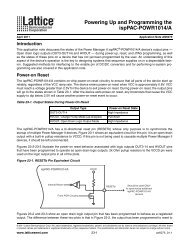Reveal Troubleshooting Guide - Lattice Semiconductor
Reveal Troubleshooting Guide - Lattice Semiconductor
Reveal Troubleshooting Guide - Lattice Semiconductor
You also want an ePaper? Increase the reach of your titles
YUMPU automatically turns print PDFs into web optimized ePapers that Google loves.
<strong>Reveal</strong> <strong>Troubleshooting</strong> <strong>Guide</strong> Signals Unavailable for Tracing and Triggering<br />
the design. In addition, some design elements may have some of these<br />
modules embedded in them, causing the design to be unusable with <strong>Reveal</strong>.<br />
Examples are the QDR and Tri-Speed MAC IPs in which ORCAstra is<br />
embedded.<br />
During the mapping process, errors can occur, such as running out of<br />
available resources or tracing or triggering on signals that are not available in<br />
the FPGA fabric. During debug insertion, the <strong>Reveal</strong> Inserter checks to make<br />
sure that the debug logic is not using more resources than are available in the<br />
FPGA. But it does not check to see if the debug logic is using more resources<br />
than are available after the design is placed in the FPGA. Currently resource<br />
usage can only be accurately checked during the mapping process.<br />
Exceeding the available resources results in a mapping error, requiring the<br />
debug configuration in the <strong>Reveal</strong> Inserter to be reduced in order to fit.<br />
Another potential failure occurs when you trigger or trace signals that are<br />
actually hard routes in the FPGA but are not available in the FPGA routing<br />
fabric, for example, the output of a SERDES block. This output is directly<br />
routed from the FPGA and is not available in the FPGA routing fabric. Many<br />
hard routes are detected and blocked from use as trigger or trace signals, but<br />
it is still possible to select some signals that cannot be connected to the<br />
debug logic.<br />
Signals Unavailable for Tracing and Triggering<br />
Some signals in a VHDL design appear in the signal hierarchy but are not<br />
available for triggering or tracing. The following signals are currently<br />
unavailable:<br />
� Signals used in “generate” statements are not available for tracing and<br />
triggering.<br />
� If function calls are used in the array declaration, the actual size of the<br />
array is unknown to the <strong>Reveal</strong> Inserter.<br />
� Signals that are user-defined enumerated types, integer type, or Boolean<br />
type are not available for tracing or triggering.<br />
Some signals in a Verilog design appear in the signal hierarchy but are not<br />
available for triggering or tracing. The following signals are currently<br />
unavailable:<br />
� Array types of two dimensions or more are not shown in the port or node<br />
section.<br />
� Undeclared wires attached to instantiated component instances are not<br />
shown in the hierarchical design tree. You must declare these wires<br />
explicitly if you want to trace or trigger with them.<br />
� If function calls are used in the array declaration, the actual size of the<br />
array is unknown to the <strong>Reveal</strong> Inserter.<br />
<strong>Reveal</strong> <strong>Troubleshooting</strong> <strong>Guide</strong> 4









